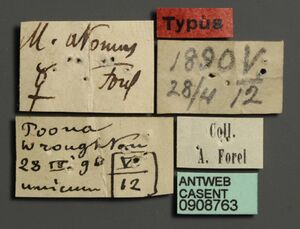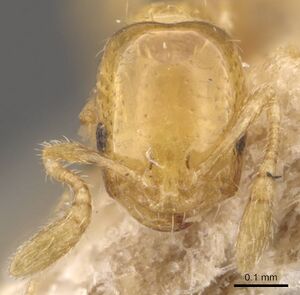Monomorium atomum
| Monomorium atomum | |
|---|---|

| |
| Scientific classification | |
| Kingdom: | Animalia |
| Phylum: | Arthropoda |
| Class: | Insecta |
| Order: | Hymenoptera |
| Family: | Formicidae |
| Subfamily: | Myrmicinae |
| Tribe: | Solenopsidini |
| Genus: | Monomorium |
| Species: | M. atomum |
| Binomial name | |
| Monomorium atomum Forel, 1902 | |
| Subspecies | |
| |
In Yemen this species was found in humid leaf litter under a date palm tree where the soil was rich in accumulations of decayed animal faeces (Sharaf et al., 2017).
| At a Glance | • Limited invasive |
Identification
Worker. Small species (TL 1.20–1.30). Head distinctly longer than broad, feebly convex or parallel sides and feebly concave posterior margin; eyes small with four or five ommatidia in the longest row; petiole peduncle in profile short and without anteroventral process. Body smooth and shining. Colour uniform yellow (Sharaf et al., 2017).
Keys including this Species
Distribution
Latitudinal Distribution Pattern
Latitudinal Range: 22.675° to 22.675°.
| North Temperate |
North Subtropical |
Tropical | South Subtropical |
South Temperate |
- Source: AntMaps
Distribution based on Regional Taxon Lists
Afrotropical Region: Socotra Archipelago, Yemen.
Oriental Region: Bangladesh, India (type locality).
Distribution based on AntMaps
Distribution based on AntWeb specimens
Check data from AntWeb
Countries Occupied
| Number of countries occupied by this species based on AntWiki Regional Taxon Lists. In general, fewer countries occupied indicates a narrower range, while more countries indicates a more widespread species. |

|
Estimated Abundance
| Relative abundance based on number of AntMaps records per species (this species within the purple bar). Fewer records (to the left) indicates a less abundant/encountered species while more records (to the right) indicates more abundant/encountered species. |

|
Biology
Castes
Worker
Images from AntWeb
   
| |
| Syntype of Monomorium atomum. Worker. Specimen code casent0908763. Photographer Will Ericson, uploaded by California Academy of Sciences. | Owned by MHNG, Geneva, Switzerland. |
   
| |
| Syntype of Monomorium atomum aharonii. Worker. Specimen code casent0908764. Photographer Will Ericson, uploaded by California Academy of Sciences. | Owned by MHNG, Geneva, Switzerland. |
   
| |
| Syntype of Monomorium atomum integrium. Worker. Specimen code casent0908765. Photographer Will Ericson, uploaded by California Academy of Sciences. | Owned by MHNG, Geneva, Switzerland. |
   
| |
| Syntype of Monomorium atomum cooperi. Worker. Specimen code casent0902276. Photographer Z. Lieberman, uploaded by California Academy of Sciences. | Owned by NHMUK, London, UK. |
Nomenclature
The following information is derived from Barry Bolton's Online Catalogue of the Ants of the World.
- atomum. Monomorium atomus Forel, 1902c: 210 (w.) INDIA (Odisha, Assam, Maharashtra, West Bengal).
- Type-material: syntype workers (number not stated).
- Type-localities: India: Orissa (Taylor), Assam (Smythies), Poona (Wroughton), Calcutta (Rothney).
- Type-depository: MHNG.
- Bingham, 1903: 208 (q.).
- Combination in M. (Martia): Forel, 1910c: 252;
- combination in M. (Lampromyrmex): Emery, 1922e: 183.
- Status as species: Forel, 1903a: 687; Rothney, 1903: 97; Bingham, 1903: 208; Arnold, 1916: 239; Emery, 1922e: 183; Chapman & Capco, 1951: 163; Ettershank, 1966: 87; Pisarski, 1967: 400; Bolton, 1995b: 259; Borowiec, L. 2014: 115 (see note in bibliography); Bharti, Guénard, et al. 2016: 39; Sharaf, Fisher, et al. 2017: 20.
- Distribution: Afghanistan, India, Yemen.
- Current subspecies: nominal plus aharonii, cooperi, integrium, procax.
Description
Worker
Bingham (1903): Pale yellow, the legs a shade paler than the liead and thorax ; entirely smooth, polished and shining : pilosity sparse, on the scape of the anteinne and tibiae of the legs oblique. Head a little broader posteriorly than in front, the posterior border slightly emarginate ; mandibles narrow, the masticatory margin with 4 teeth, maxillary palpi l-jointed ; Clypeus slightly convex, the carinae strongly convergent above, obtuse ; antennae 11-jointed, very short, the scape not nearly attaining the posterior margin of the head ; eyes placed below the middle of the side of the head. Thorax : the pro-raesonotum very convex, meso-metanotal suture deeply impressed, the thorax constricted at the suture and in profile emarginate above ; basal portion of metanotum rectangular, a very little longer than broad. Pedicel : the nodes from above subequal, globose, the 1st node anteriorly petiolate ; abdomen oval.
Length: ~ 1.5 (1.2 - 1.3) mm
Queen
References
- Bingham, C. T. 1903. The fauna of British India, including Ceylon and Burma. Hymenoptera, Vol. II. Ants and Cuckoo-wasps. London: Taylor and Francis, 506 pp. (page 208, queen described)
- Borowiec, L. 2014. Catalogue of ants of Europe, the Mediterranean Basin and adjacent regions (Hymenoptera: Formicidae). Genus (Wroclaw) 25(1-2): 1-340.
- Forel, A. 1902c. Myrmicinae nouveaux de l'Inde et de Ceylan. Rev. Suisse Zool. 10: 165-249 (page 210, worker described)
- Forel, A. 1910c. Ameisen aus der Kolonie Erythräa. Gesammelt von Prof. Dr. K. Escherich (nebst einigen in West-Abessinien von Herrn A. Ilg gesammelten Ameisen). Zool. Jahrb. Abt. Syst. Geogr. Biol. Tiere 29: 243-274 (page 252, Combination in M. (Martia))
- Sharaf, M.R., Fisher, B.L., Collingwood, C.A., Aldawood, A.S. 2017. Ant fauna (Hymenoptera: Formicidae) of the Socotra Archipelago (Yemen): zoogeography, distribution and description of a new species. Journal of Natural History 51, 317–378 (DOI 10.1080/00222933.2016.1271157).
- Wang, W.Y., Soh, E.J.Y., Yong, G.W.J., Wong, M.K.L., Benoit Guénard, Economo, E.P., Yamane, S. 2022. Remarkable diversity in a little red dot: a comprehensive checklist of known ant species in Singapore (Hymenoptera: Formicidae) with notes on ecology and taxonomy. Asian Myrmecology 15: e015006 (doi:10.20362/am.015006).
References based on Global Ant Biodiversity Informatics
- Borowiec L. 2014. Catalogue of ants of Europe, the Mediterranean Basin and adjacent regions (Hymenoptera: Formicidae). Genus (Wroclaw) 25(1-2): 1-340.
- Forel A. 1902. Myrmicinae nouveaux de l'Inde et de Ceylan. Rev. Suisse Zool. 10: 165-249.
- Forel A. 1903. Les Formicides de l'Empire des Indes et de Ceylan. Part X. J. Bombay Nat. Hist. Soc. 14: 679-715.
- Pisarski B. 1967. Fourmis (Hymenoptera: Formicidae) d'Afghanistan récoltées par M. Dr. K. Lindberg. Annales Zoologici (Warsaw) 24: 375-425.
- Tak N. 1995. Studies on ants (Formicidae) of Rajasthan - 1 Jodhpur. Hexapoda 7(1): 17-28.
- Tak N. 2008. Ants of Rajasthan. Conserving Biodiversity of Rajasthan Zool. Surv. India. 149-155.
- Tak N. 2009. Ants Formicidae of Rajasthan. Records of the Zoological Survey of India, Occasional Paper No. 288, iv, 46 p
- Tak N., and N. S. Rathore. 1996. Ant (Formicidae) fauna of the Thar Desert. Pp. 271-276 in: Ghosh, A. K.; Baqri, Q. H.; Prakash, I. (eds.) 1996. Faunal diversity in the Thar Desert: gaps in research. Jodhpur: Scientific Publishers, xi + 410 pp.
- Tak, N. 2009. Ants (Hymenoptera: Formicidae) of the Thar Desert of Rajasthan and Gujarat. in C. Sivaperuman et al. (eds.), Faunal Ecology and Conservation of the Great Indian Desert
- Varghese T. 2004. Taxonomic studies on ant genera of the Indian Institute of Science campus with notes on their nesting habits. Pp. 485-502 in : Rajmohana, K.; Sudheer, K.; Girish Kumar, P.; Santhosh, S. (eds.) 2004. Perspectives on biosystematics and biodiversity. Prof. T.C. Narendran commemoration volume. Kerala: Systematic Entomology Research Scholars Association, xxii + 666 pp.

